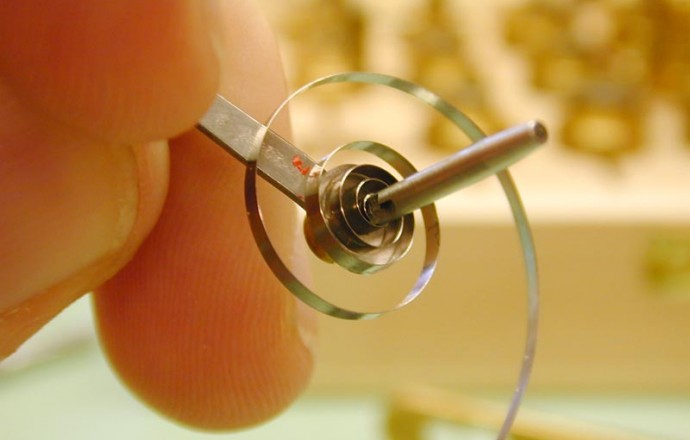A spring driven watch derives all of its power from the mainspring. The mainspring must be in good condition with no burrs, rust or kinks and must be clean and properly lubricated if it is expected to deliver its full power to the works. The coils must be able to slide freely with no obstruction as it slowly unwinds. If its surface has any burrs or scratches it may catch or bind in places causing uneven power transfer to the train. If the coils cannot slide smoothly along the surfaces of one another they will tend to stick together for awhile until finally slipping. The sticking together of the coils causes uneven power distribution and will reveal itself in fluctuating tick amplitude. If you notice that the watch has a soft tick and then becomes noticeably louder then soft again and does not follow any predictable pattern then there is a good chance the mainspring needs some attention. The arc or motion of the balance wheel may also vary if the spring sticks together for long periods of time and then suddenly slips. Of course there are other situations that can cause similar symptoms such as bent pivots or bent wheel teeth but these symptoms will usually repeat themselves in a regular pattern. When winding a mainspring for the first time after it has been cleaned and greased it’s very important to wind it fully, let it back down and then wind it fully again. If using a mainspring winder do this in the winder several times and then inspect the spring to see that the grease has spread evenly over the entire spring. This includes the most inner coils where most of the pressure is exerted. This helps to distribute the grease evenly along the springs width and length. Failing to do this will often cause uneven power distribution
Improper mainspring replacement is something you will encounter periodically in both watch and clock repair. Often a watchmaker does not possess or cannot locate an exact replacement spring for an older timepiece, substituting the original spring for one with the nearest dimensions possible. If certain precautions are not considered this may result in difficult to diagnose problems. If a mainspring is chosen that is too wide it will press against the bottom and cap of the barrel which will result in jamming the mainspring and obstruct the smooth slipping motion necessary for a spring to function correctly. If the barrel cap is not seated flat in its barrel seat then as mentioned earlier too wide a spring is suspect. Again, tolerances are so close in watches and clocks that you will often see scratch or wear marks scraped on the outside of a protruding cap by a close running center wheel, center wheel bridge, barrel bridge or plate. It’s necessary to mention here that these same symptoms can occur from a spring that has been incorrectly wound into a barrel by hand rather than with a mainspring winder. If not done properly it can distort the spring into a conical shape. You can check this by laying the spring on a flat surface. If it doesn’t lay flat but instead assumes a cone shape then when installed in the barrel it will exert some pressure on the bottom and cap of the barrel dissipating some of its energy in the wrong direction.

